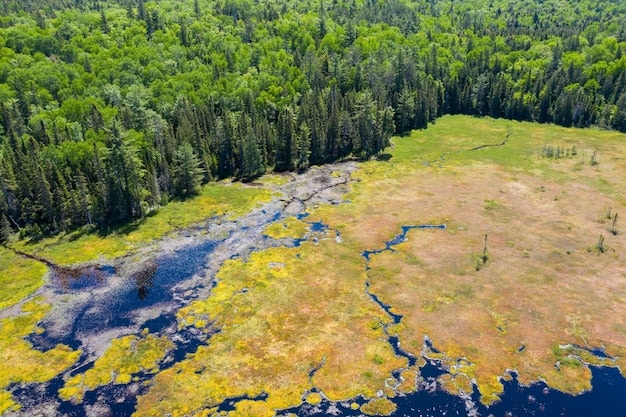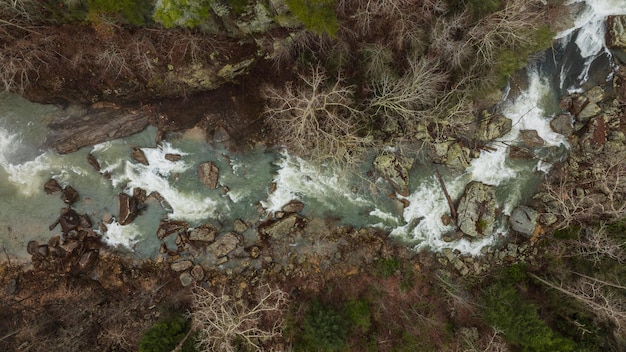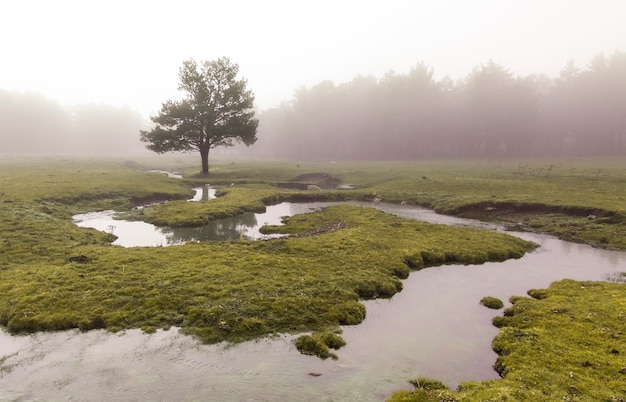Deforestation’s Impact on US Water: New Study & Solutions

A groundbreaking new study reveals the critical impact of deforestation across the United States on vital water resources, exacerbating issues from water quality degradation to increased flood risks. This research highlights an urgent need for proactive solutions to protect ecosystem health and ensure sustainable water availability for communities nationwide.
A recent, compelling study has shone a spotlight on a critical environmental issue: the profound impact of deforestation on water resources across the United States. This research provides a stark reminder that while the clearing of forests might seem like a localized issue, its consequences ripple far beyond, directly affecting the quality and quantity of water available to communities nationwide. Understanding these complex interconnections is the first step toward safeguarding one of our most precious natural assets.
The Intertwined Fate: Forests, Water, and a New Call to Action
The relationship between forests and water is ancient and fundamental. Forests act as natural sponges, filtering water, recharging aquifers, and regulating streamflows. When these essential ecosystems are disturbed or removed through deforestation, this delicate balance is profoundly disrupted, leading to a cascade of environmental and societal challenges.
Recent studies offer compelling evidence of this link, pushing for a more urgent and coordinated response. This isn’t merely an academic exercise; it’s a call to understand and address the direct threats to America’s water supply.
The latest findings are particularly concerning for the US water resources landscape, revealing a nuanced and often underappreciated dimension of environmental degradation. Scientists used advanced satellite imagery, hydrological modeling, and long-term ecological data to piece together a comprehensive picture of how forest loss directly correlates with measurable changes in water systems.
Understanding the Hydro-Ecological Connection
Forests play a crucial role in the water cycle in several ways:
- They intercept rainfall, reducing erosion and runoff.
- Their root systems stabilize soil, preventing sediment from entering waterways.
- Transpiration by trees releases water vapor, influencing local and regional precipitation patterns.
- Forest canopies moderate water temperatures in streams, vital for aquatic life.
The new research leverages this understanding, demonstrating how shifts in forest cover translate into tangible impacts on water quality and availability. This provides a scientific foundation for policy-makers and conservationists to develop more effective strategies.
The study’s methodology combined remote sensing data with on-the-ground measurements, offering an unprecedented level of detail regarding the spatial and temporal dynamics of deforestation and its subsequent effects on river basins and groundwater tables. It highlighted specific regions within the US that are particularly vulnerable, pinpointing hotbeds of concern where deforestation is accelerating adverse hydrological outcomes. For communities in these areas, the findings underscore immediate risks to both public health and economic stability.
This holistic approach paints a vivid picture, moving beyond local observations to national trends. It underscores that while regional variations exist, the overarching pattern of negative impacts from forest loss on water resources is consistent across diverse ecosystems within the United States. This collective evidence strengthens the case for integrated land and water management solutions on a broader scale.
Key Findings: How Deforestation Impacts US Water Resources
The new study presents several alarming findings regarding deforestation’s specific impacts on US water resources. These aren’t abstract ecological concepts but direct threats to the quantity, quality, and overall health of our nation’s water systems.
One of the most persistent and widespread consequences highlighted is the significant degradation of water quality. When forests are removed, the protective canopy and root systems that filter pollutants and prevent soil erosion are lost. This leads to increased sediment runoff into rivers and streams, clouding water and making it more difficult and costly to treat for drinking.
Sedimentation and Pollution Escalation
The study found a direct correlation between the rate of deforestation and the concentration of suspended solids in nearby waterways. Beyond just soil particles, deforested areas often see an increase in nutrient runoff from agriculture or urban development, leading to:
- Eutrophication: Excessive nutrients cause algal blooms, depleting oxygen and harming aquatic life.
- Increased pathogen loads: Runoff from deforested areas can carry bacteria and viruses into water sources.
- Chemical contamination: Without natural filtration, pesticides and other chemicals can more easily reach water bodies.
These quality issues pose significant risks to human health and impose substantial costs on municipal water treatment facilities, which often pass these expenses onto consumers. The presence of excessive sediment and pollutants also hinders recreational activities, impacting local economies that rely on healthy rivers and lakes.
Another critical finding centers on the altered hydrological patterns. Forests act as natural regulators, absorbing rainfall and releasing it slowly over time. The removal of this natural infrastructure leads to more rapid runoff, higher peak flows during storms, and lower base flows during dry periods.

Exacerbated Flood Risks and Drought Vulnerability
The study indicates that regions experiencing significant deforestation are seeing a measurable increase in both the frequency and intensity of flash floods. This is a direct result of forests no longer being present to slow down and absorb rainfall. Conversely, during periods of drought, these same areas often suffer from reduced streamflow because the forest’s ability to store and gradually release groundwater is diminished.
The implications are far-reaching:
- Damage to infrastructure: Increased flooding can destroy roads, bridges, and homes.
- Agricultural losses: Both floods and droughts devastate crops and livestock.
- Decreased water availability: Reduced base flows threaten water supplies for communities, industry, and agriculture during dry months.
Furthermore, the study points to impacts on aquatic ecosystems. Changes in water temperature, increased sedimentation, and altered flow regimes directly stress fish populations and other aquatic organisms, potentially leading to species loss and a decline in biodiversity. These findings collectively paint a stark picture, underscoring the urgent need for intervention regarding the health and sustainability of US water resources.
Case Studies: Deforestation’s Grip on Regional Waterways
The new study doesn’t just offer broad national trends; it delves into specific regional case studies that illuminate the tangible impacts of deforestation on US water resources. These localized examples provide powerful real-world illustrations of the hydrological shifts and environmental degradation discussed in the broader findings.
For instance, one prominent case study focused on areas within the Pacific Northwest, a region historically rich in timber resources. While logging practices have evolved, historical and ongoing clear-cutting in certain watersheds has been directly linked to increased instances of landslides and heightened sediment loads in major salmon-bearing rivers. This not only impacts water quality for human consumption but also severely threatens ecologically and economically vital fish populations, disrupting entire ecosystems.
The Southern Appalachian Story: From Timber to Turbidity
Another compelling example emerged from the Southern Appalachian Mountains. Here, a combination of historical logging, agricultural conversion, and more recent development projects has led to significant forest loss. The study meticulously tracked waterways in these affected areas, revealing a clear pattern:
- Increased Turbidity: Rivers and streams in deforested areas consistently showed higher levels of suspended solids, making water less clear and reducing light penetration for aquatic plants.
- Altered Flow Regimes: These same areas experienced more extreme fluctuations in water levels – faster, higher peaks during storms and diminished flow during dry spells, stressing aquatic habitats.
- Impact on Biodiversity: The changes in water quality and flow have been directly correlated with declines in amphibian and fish species sensitive to habitat disturbance.
These changes are critical not only for local ecosystems but also for communities downstream that rely on these rivers for drinking water, recreation, and economic sustenance. The purity of these upstream forests directly translates to the health of the entire river system.
The study also examined the Upper Midwest, particularly regions where agricultural expansion has historically replaced dense forest cover. Here, the impact wasn’t just on sedimentation but also on nutrient runoff. Without the natural buffer zones provided by forests along riverbanks, excessive nitrates and phosphates from agricultural fertilizers easily enter waterways, contributing to problems like the Gulf of Mexico’s dead zone.

These diverse case studies underscore a crucial point: while the mechanisms of deforestation’s impact remain consistent, the specific manifestations vary depending on regional geography, climate, and land-use history. Whether it’s salmon habitat degradation in the Pacific Northwest, ecological stress in the Appalachians, or nutrient loading in the Midwest, the message is clear. Forest preservation and restoration are indispensable for protecting the US water resources that sustain both nature and human society. Each regional narrative reinforces the overarching scientific findings, demanding tailored yet unified solutions.
Policy and Economic Ramifications of Degraded Water Resources
The environmental consequences of deforestation on water resources in the US are profound, but their ripple effects extend deeply into policy decisions and economic stability. Degraded water quality and altered hydrological patterns don’t just affect ecosystems; they impose tangible costs on communities and challenge governmental management strategies.
From a policy perspective, the study’s findings highlight critical gaps and the urgent need for more robust regulatory frameworks. Current land-use planning often fails to adequately account for the downstream impacts of forest conversion. This leads to a reactive approach, where problems like increased water treatment costs or flood damage are addressed after they occur, rather than through proactive preservation.
Economically, the costs are multifaceted. Municipalities face escalating expenses for water purification as source water becomes more polluted with sediment and chemicals. These costs are often passed directly to consumers through higher utility bills. Beyond direct treatment, there are significant expenses associated with flood damage, including:
- Infrastructure repair: Roads, bridges, and public utilities damaged by increased flood events.
- Agricultural losses: Crops and livestock are vulnerable to both flooding and drought, impacting farmer livelihoods and food supply chains.
- Tourism and recreation decline: Degraded water quality and habitat loss deter fishing, boating, and other water-based tourism, affecting local economies.
The new research also brings to light the concept of “natural capital” and the economic value of ecosystem services provided by forests. By quantifying the hydrological benefits of forests – such as water filtration, flood control, and groundwater recharge – the study provides a powerful argument for investing in forest conservation and restoration as a cost-effective alternative to engineered solutions.
Public Health and Environmental Justice Concerns
Beyond the financial implications, degraded water quality poses significant public health risks. Increased pathogens and chemical contaminants can lead to waterborne illnesses, disproportionately affecting vulnerable populations who may lack access to alternative clean water sources or adequate healthcare. This introduces an environmental justice dimension, where the environmental burdens of deforestation are not equally distributed among all communities.
The study urges policy-makers to consider these broader societal costs when evaluating land-use projects. It advocates for integrated water resource management plans that prioritize forest protection and reforestation as central pillars for ensuring long-term water security. This shift recognizes that healthy forests are not just aesthetic assets but essential infrastructure for a safe and sustainable water supply, critical for the future well-being and economic prosperity of the US water resources.
Innovative Solutions: Reforestation, Conservation, and Sustainable Practices
The alarming insights from the new study underscore the urgent need for effective, scalable solutions to mitigate deforestation’s impact on US water resources. Fortunately, a diverse array of innovative strategies is emerging, focusing on reforestation, advanced conservation techniques, and embracing more sustainable land management practices.
Reforestation and Afforestation are cornerstone solutions. Reforestation involves replanting forests in areas where they have been cleared, while afforestation means establishing new forests where none existed previously. These efforts are not just about planting trees; they involve thoughtful planning to select native species suitable for the local climate and hydrological conditions. Large-scale reforestation initiatives across critical watersheds can significantly improve water quality by reducing erosion and filtering pollutants, while also enhancing groundwater recharge.
Advanced Conservation Strategies
Beyond simply planting trees, several advanced conservation approaches are proving effective:
- Riparian Buffer Zones: Establishing and protecting forested strips along rivers and streams is crucial. These buffers act as natural filters, preventing agricultural runoff and sediment from entering waterways, while also stabilizing banks and providing shade to regulate water temperature.
- Sustainable Forestry Practices: Moving away from clear-cutting towards selective logging, where only mature trees are harvested, can minimize ecological disturbance and maintain forest cover. Certifications like the Forest Stewardship Council (FSC) promote responsible forest management.
- Protected Areas and Land Acquisition: Designating and expanding national parks, forests, and other protected areas specifically for their role in watershed protection is vital. Land trusts and conservation groups play a key role in acquiring critical forest lands to prevent their conversion.
Technological advancements are also playing a significant role. Remote sensing and GIS (Geographic Information Systems) allow for precise monitoring of deforestation rates and water quality changes, enabling targeted interventions. Drone technology can efficiently survey and even reseed remote or difficult-to-access areas.
Community engagement is another critical component. Educating landowners, farmers, and local communities about the value of healthy forests for water quality can foster a sense of stewardship. Incentive programs, such as payments for ecosystem services, can encourage private landowners to adopt forest-friendly practices.
The path forward involves a multi-pronged approach encompassing policy changes, technological innovation, and grassroots initiatives. By prioritizing these solutions, the US can begin to reverse the tide of deforestation’s negative impacts and secure the long-term health and availability of its precious US water resources for future generations.
Policy Pathways and Community Engagement for Water Security
Addressing the complex challenge of deforestation’s impact on US water resources demands not only innovative environmental solutions but also robust policy frameworks and active community engagement. Without supportive governance and public participation, even the best scientific strategies risk falling short.
At the federal level, strengthened environmental regulations are essential. This includes enhancing protections for critical wetlands and headwater forests under acts like the Clean Water Act and expanding the scope of the National Environmental Policy Act (NEPA) to more broadly assess hydrological impacts of land-use changes. Incentivizing states and private landowners to conserve forests through tax breaks, grants, and conservation easements can also drive significant change.
State and Local Initiatives are Crucial
While federal policy sets the overarching tone, state and local governments are often on the front lines:
- Watershed Protection Programs: Many states have established programs specifically designed to protect water quality through forest conservation. These can include zoning laws that restrict development in sensitive areas and financial incentives for reforestation.
- Urban Forestry Initiatives: Cities are increasingly recognizing the role of urban forests in managing stormwater runoff and improving local water quality. Tree planting programs within urban boundaries can have a measurable impact.
- Interstate Compacts: For major river basins that cross state lines, creating or strengthening interstate agreements is vital for coordinated conservation efforts that manage forests and water resources holistically.
Beyond government action, community engagement is paramount. Local residents, businesses, and non-profit organizations are powerful agents of change. Empowering communities through educational programs about the link between forests and water can foster a sense of ownership and motivate collective action.
This includes supporting citizen science initiatives where volunteers help monitor water quality, identify areas of concern, and participate in restoration projects. Local land trusts, for example, play a critical role in purchasing and protecting key forest properties adjacent to water sources, often with significant community support.
Furthermore, partnerships between government agencies, academic institutions, and environmental groups can leverage diverse expertise and resources. These collaborations can lead to more effective policy development, better scientific understanding, and more successful implementation of conservation projects.
Ultimately, securing US water resources against the threats of deforestation requires a comprehensive approach that integrates scientific understanding with proactive policy-making and widespread community involvement. By working together, we can ensure that forests continue to perform their vital role in sustaining clean and abundant water for all.
Looking Ahead: Investing in the Future of US Water Resources
The new study’s findings are not merely a report on the past; they serve as a powerful call to action for the future of US water resources. The trajectory of deforestation and its hydrological impacts suggests that without significant intervention, the challenges will only intensify. Therefore, looking ahead, strategic investments in forest health and integrated water management are indispensable.
A primary focus must be on long-term investment. This means allocating sustained funding for scientific research to better understand forest-water dynamics, developing advanced ecological restoration techniques, and investing in monitoring infrastructure. Such investments ensure that solutions are continually adapted to changing environmental conditions and emerging threats.
Prioritizing Ecosystem-Based Management
Moving forward, a shift towards ecosystem-based management is crucial. This approach recognizes the interconnectedness of forests, rivers, and all living components within a watershed, managing them as a whole rather than in isolated parts. Key elements include:
- Holistic Watershed Planning: Developing plans that consider all land uses within a watershed, prioritizing forest retention and restoration for water quality.
- Climate Resilience: Integrating climate change projections into forest management, focusing on tree species and forest structures that are more resilient to changing weather patterns, which in turn protects water resources.
- Green Infrastructure: Investing in natural solutions like forests and wetlands as primary infrastructure for water management, rather than relying solely on engineered solutions like dams and levees.
Education and public awareness campaigns will also play a vital role in shaping future policies and individual behaviors. A well-informed public is more likely to support conservation initiatives, elect leaders who champion environmental protection, and adopt sustainable practices in their daily lives. School curricula, public outreach programs, and media engagements can elevate the importance of forests to water security.
Finally, fostering international collaboration can provide valuable insights and technological transfers. The challenges of deforestation and water insecurity are global, and sharing best practices with other nations facing similar issues can accelerate progress within the US.
The health of our forests is inextricably linked to the health of our water supply. The revelations from this new study underscore that proactive, multi-faceted investment in forest conservation and restoration is not an option but a necessity. By making these commitments today, we can secure vibrant ecosystems and sustainable US water resources for generations to come, transforming a concerning report into an actionable blueprint for positive change.
| Key Aspect | Brief Description |
|---|---|
| 🌳 Deforestation Impact | New study reveals loss of forests significantly degrades US water quality and quantity. |
| 💧 Water Quality Issues | Increased sedimentation, pollution (nutrients, chemicals), and pathogen loads post-deforestation. |
| 🌊 Hydrological Changes | Leads to higher flood risks and increased vulnerability to droughts in affected regions. |
| 🌱 Key Solutions | Reforestation, riparian buffers, sustainable forestry, policy changes, and community engagement. |
Frequently Asked Questions About Deforestation and US Water Resources
The study primarily finds a direct and critical link between forest loss across the US and the degradation of national water resources. It highlights increased sedimentation, pollution, and altered hydrological patterns, such as heightened flood risks and reduced water availability during dry spells, directly attributable to deforestation.
Deforestation impacts water quality by removing the natural filtration system forests provide. This leads to increased soil erosion and sediment runoff into waterways. It also allows more pollutants, like agricultural nutrients and chemicals, to enter rivers and streams, contributing to issues such as eutrophication and chemical contamination.
Economically, degraded water resources mean higher municipal water treatment costs, often passed to consumers. There are also significant costs from increased flood damage to infrastructure and agricultural losses due to altered water flows. Furthermore, the decline in ecosystem services provided by forests, like natural filtration, has an unquantified but substantial economic impact.
Key solutions include widespread reforestation and afforestation efforts, establishing robust riparian buffer zones, and implementing sustainable forestry practices. Policy changes, stronger regulations, and active community engagement are also crucial in protecting critical forested watersheds and promoting responsible land use to restore and preserve water health.
Communities can contribute by participating in local reforestation projects, supporting land trusts, and advocating for stronger environmental policies. Educating themselves and others on the forest-water connection, adopting sustainable land management practices, and engaging in citizen science initiatives for water quality monitoring are also effective ways to make a positive impact.
Conclusion
The latest study on the impact of deforestation on US water resources serves as a pivotal moment, shifting our understanding from anecdotal evidence to concrete scientific findings. It unequivocally demonstrates that the health of our forests is directly and intrinsically linked to the availability and purity of our water. The critical challenges of increased sedimentation, escalating pollution, and altered hydrological patterns call for immediate and decisive action. By prioritizing reforestation, embracing sustainable land management, and fostering robust policy support and community engagement, we can collectively work to safeguard these vital resources. The future of America’s water security depends on our ability to value and protect the natural infrastructure that forests provide, turning the insights of this study into a blueprint for a healthier, more sustainable future.





